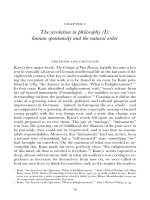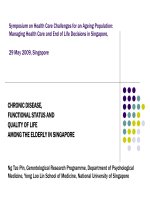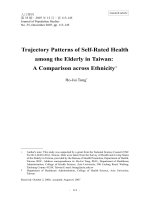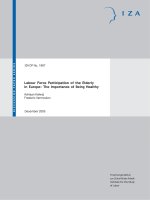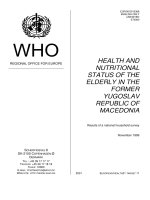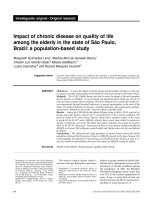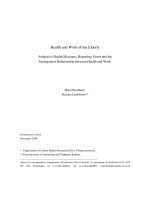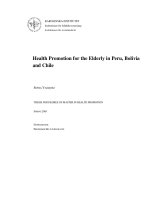POVERTY OF THE ELDERLY IN DANANG CITY IMPACT FACTORS AND ROLE OF CASH ASSISTANCE PROGRAM
Bạn đang xem bản rút gọn của tài liệu. Xem và tải ngay bản đầy đủ của tài liệu tại đây (518.6 KB, 32 trang )
MINISTRY OF EDUCATION AND TRAINING
THE UNIVERSITY OF DANANG
HUYNH VAN THANG
POVERTY OF THE ELDERLY IN DANANG CITY:
IMPACT FACTORS AND ROLE OF
CASH ASSISTANCE PROGRAM
Major: Development economics
Code: 62.31.01.05
Old Major: Industrial Economy
Code: 62.31.09.01
SUMMARY OF ECONOMIC DISSERTATION
Danang, 2017
The thesis was completed at
THE UNIVERSITY OF DANANG
Instructor 1: DR. Nguyễn Hiệp
Instructor 2: ASSOC.PROF.DR Giang Thanh Long
Objection 1: ASSOC.PROF.DR Bui Dung The
Objection 2: ASSOC.PROF.DR Bui Quang Binh
Objection 3: ASSOC.PROF.DR Nguyen The Tram
The dissertation is presented in front of Board of Thesis of
the University of Danang on 25-8-2017.
The dissertation can be found at:
- National Library of Vietnam
- Academy Information Center – the University of Danang
1
PREFACE
1. Urgency of the study
Population aging is the inevitable trend of the developed countries
as well as developing ones when the birth rate and mortality reduces
and the average life expectancy increases; Vietnam is also in this
situation. Along with the general trend of the country, Danang is also
facing population aging and having rapid growth rate compared with
other areas in Vietnam. According to forecast data of the General
Bureau of Statistics (2011), the percentage of old people in Danang
accounted for 7.9% in 2014 and would increase 16.8% in 2034.
Population aging poses several urgent problems of social security for
the elderly. For Vietnam in general and Danang in particular, solving
the problem of the elderly poverty is extremely difficult while the
security is still at low level.
There have been lots of researches on the poverty status in general
and that of the elderly in particular domestically and internationally.
However, until now, there have not been any certain studies on the
causes of the elderly poverty and the role of cash assistance program to
reduce poverty for old people. Therefore, the study on "Poverty of the
elderly in Danang city: Impact factors and Role of cash assistance
program" is absolutely necessary and urgent.
2. Objectives of the study
The thesis identifies these following specific objectives:
1) Combining and developing systematically the theoretical basis
of the poverty, poverty status of the elderly, poverty of households
having the elderly; the impact factors affecting the poverty and its
impact channels; and the role of cash assistance program to reduce
poverty status of the elderly as a solid basis for further targets;
2
2) Evaluating the authentic poverty status of households having the
elderly; Describing the basic characteristics of cash assistance policy
for the elderly in Danang;
3) Analyzing and evaluating the causes of the elderly’s poverty in
Danang by the analyzing the impact of several impact factors to the
probability of poverty of households having old people.
4) Evaluating the authentic role of cash assistance programs for the
elderly in Danang by evaluating the impact of the program to the
poverty situation of the elderly in society in general and the elderly
themselves in particular;
5) Suggesting some basic and feasible policy implications, aimed at
poverty-reducing targets for the elderly in Danang, which focus on the
policy implications of government’s subsidies via the directly cash
assistance program.
3.
Objects of the study
This thesis focuses mainly on the following objects:
1) Poor household status with elderly in Da Nang.
2) Factors that primarily affect the probability of poverty among
households with elderly.
3) Assess the impact of the monetary assistance program on poverty
reduction for elderly households in Da Nang.
4.
Scope of the study
The scope of the objects of study: Objects of research is
Danang's population over the period 2016-2035 obtained from
population prediction by the General Bureau of Statistics (2011), which
focuses on households having the elderly. The other objects include
several policies related to the elderly and households having the elderly;
stakeholders of the central as well as local government in planning and
implementing of supportive policies for the elderly (Department of
3
Labour, Invalids and Social Affairs; Fatherland Front; Danang board of
the elderly representatives Association; Committee and the relevant
industries, organizations of all levels).
The scope of research space: Danang city.
The scope of research period:
+ Studying the reality of poverty and the impact factors which are
limited from 2014 to the past and forecast data until 2034.
+ Analyzing the role of cash assistance program from 2015
onwards.
+ Suggesting some policy implications based on environmental
forecasting of future policies in medium and long term (from 2015).
5. Research’s methodology
5.1. Data collection methods
The thesis uses the data of Danang from population prediction by
the General Bureau of Statistics (2011) , Survey of Household Living
Standard (VHLSS) in 2006, 2010, 2014 for the whole country and
Danang; Reports of all-level agencies, organizations working for the
elderly in Danang; National survey data on the elderly in 2012 to
identify a number of factors related to the health and usage of health
care services of women and older men (the elderly aged more than 60
years) via the feces bivariate and multivariate.
5.2. Analysis and evaluation methods
The thesis shall use and combine the following methodology:
Statistical description Method: Used commonly in describing
the overall study, environmental research conditions, and the poverty
status of the elderly in Danang. Statistical indicators are mainly the
scale, the average number and frequency which are assessed via the
review of proportion, percentage or rate of change over time.
4
Regression Method: To evaluate the impact of factors affecting
the poverty of households having the elderly, the thesis applies the
method of multivariate regression with probit probability models in
which the dependent variable is the poverty status of households having
the elderly in Danang and the explanatory variables include personal
characteristics variants (such as age, gender, education, job ...) and
family characteristics variants (such as living places, gender and
education background of household owners, number of children in the
household ...).
Micro-simulation Method: In the assessment of the cash
assistance program, the thesis uses micro-simulation method to find out
the relationship between supporting content and the reality of poverty
and the status of inequality of income (or expenditure) of the elderly.
Besides, to suggest some specific policy implications, the microsimulation method is also used to forecast the cost of expanding cash
subsidy policy for different elderly people as well as approach a
universal system for the entire elderly in Danang.
Methods of analyzing qualitative data based on fieldwork: To
illustrate, in more details, some claims from the quantitative approach,
based on qualitative data from field surveys at some places in Danang
(municipal, district, commune, village levels with objects surveyed
include the elderly and the agency leaders and local organizations), the
methods of logical deduction qualitative approach will be used.
6. Theoretical and practical meaning of the study
* Theoretical meaning:
Generalize in a systematic way the theoretical issues in the
study of poverty status of the elderly.
Providing empirical evidence on the relationship of the impact
factor has a great influence on the poverty status of the elderly in
5
Vietnam (Danang in particular), especially on the role of cash
assistance policies in reducing poverty.
* Practical meaning:
Providing stakeholders the information and evaluating the
authenticity of poverty, identifying the existences and causes of the
current existence to the poor condition of the elderly in Danang,
proposing building up the policies for the elderly, solutions-oriented,
which focus on the cash assistance programs.
7. Structure of the thesis
The thesis consists of four chapters as follows:
Chapter 1: Theoretical basis
The thesis will systematize the views and definitions. Overview of
local and international research related to poverty among elderly,
impact factors, and monetary assistance programs for elderly.
Chapter 2: Research Methods
The thesis describes the calculation method and the econometric
model together with the secondary data. At the same time, the thesis
describes how to conduct additional fieldwork for quantitative analysis.
Chapter 3: Results and analysis
Provides quantitative analysis of the status quo, factors that can
impact the poverty of elderly households in Da Nang; Quantitative and
qualitative analysis of the impact of the monetary assistance program on
poverty of the elderly in Da Nang as well as some other related impacts.
Chapter 4: Policy implications
This chapter will discuss and propose some related policies to
reduce poverty in households with older adults more sustainably.
6
CHAPTER 1
THEORETICAL BASIS
1.1. Research at home and abroad
It can be said that the study of poverty in general and that of the
elderly in particular domestically and internationally are very abundant
and diverse in many different aspects, and also indicate the impact
factors (some case studies such as Giang and Pfau, 2009a; 2009b;
2009c; Mujahid et al, 2008; Weeks et al, 2004; Matsaganis et al, 2000
... In particular, typical research of Giang Thanh Long and Hoang
Chinh Thon (2013) assessed the feasibility of cash subsidies for the
poor and vulnerable elderly in Vietnam.
Several research results indicate that there is an increase in the
aging population, in which the proportion of the elderly living alone or
living together tends to increase while the proportion of those who
depends on family is declining. Compared with older men, elderly
women faced with many difficulties and often be vulnerable due to
socio-economic risks, especially in the case of widows and loweducation level ones. The study also found a clear difference in the
poverty indicators between regions and between urban - rural.
However, there have not been any certain studies on the causes of
the elderly poverty and the role of cash assistance program to reduce
poverty for old people. In the process of urbanization in Danang for the
past few years, poverty is also urgent situation and the concern of all
levels of government leaders. Moreover, along with the country, when
the population of Danang is about to enter the aging stage and the aging
rate is really high, the real research about this issue is very essential.
1.2. General issues of poverty
7
1.2.1. Perceptions of poverty
There are a lot of different concepts of poverty, such as UN ESCAP
(1993) defines "Poverty is the state that a part of the population does
not enjoy and satisfy with the basic needs of human acknowledged by
the society, depending on the level of socio-economic development and
customs of each locality". This is quite adequate concept of poverty and
is accepted by many countries all over the world, including Vietnam.
1.2.2. Poverty Standard
To distinguish between the poor and non-poor, there is criteria
“poverty standard”. Different organizations use different poverty
standards to evaluate wealth and poverty.
1.3. The conception of the elderly
“Elderly people” or “the elderly” is a term used to describe people
who generally have more living years. For years, people all over the
world still use the term "the old". According to Vietnamese dictionary,
“old” means "at the age of weakened physiological phenomena at the
final stages of the process of natural life." So, in the use of the term,
"the elderly" or "elderly" are just two different words which carry the
same content "people have more living years compared to the average
age".
In this thesis, the author uses the term "elderly" under Article 2,
Elderly Law 2009, which means: "Elderly people are citizens of
Vietnam from 60 years old or more". However, in some analyzes, for
comparison with the countries of demographic change and policy
implications, thesis using the definition, which is ” Elderly people are
those from 65 years old or more”. The poor elderly are those who are
aged 60 years or more, living in poor households.
8
1.4. Population aging and some relevant terms
“Population aging” means the process of aging of the population
aging, as in the structure of population, the proportion of elderly is
increasing. "Population aging" or "aging population" is the population
that 65 year-old people accounts for over 7% of the total population (or
60 year-old people accounts for over 10% of the total population).
Similarly, "Aging population", "Very old" and "Super-aged" when 65
year-old people account for 10%, 20% and 30% of the total population
or more (or 65 year-old people account for 20% , 30% and 35% or
more).
"Social support" is the help of the Government and Society in terms
of income and other essential living conditions for all member of
society in cases of misfortune, risk, poverty, not afford to take care of
the minimum level of life for themselves and their family.
1.5. Factors affecting the elderly’s poverty
There are many impact factors, such as:
- Factor of natural, economic – social conditions.
- Factors of the poor themselves
- Other factors…(economic and social effects).
1.6. Research at home and abroad
It can be said that the study of poverty in general and that of the
elderly in particular domestically and internationally are very abundant
and diverse in many different aspects, and also indicate the impact
factors (some case studies such as Giang and Pfau, 2009a; 2009b;
2009c; Mujahid et al, 2008; Weeks et al, 2004; Matsaganis et al, 2000
... In particular, typical research of Giang Thanh Long and Hoang
Chinh Thon (2013) assessed the feasibility of cash subsidies for the
poor and vulnerable elderly in Vietnam.
9
Several research results indicate that there is an increase in the
aging population, in which the proportion of the elderly living alone or
living together tends to increase while the proportion of those who
depends on family is declining. Compared with older men, elderly
women faced with many difficulties and often be vulnerable due to
socio-economic risks, especially in the case of widows and loweducation level ones. The study also found a clear difference in the
poverty indicators between regions and between urban - rural.
However, there have not been any certain studies on the causes of
the elderly poverty and the role of cash assistance program to reduce
poverty for old people. In the process of urbanization in Danang for the
past few years, poverty is also urgent situation and the concern of all
levels of government leaders. Moreover, along with the country, when
the population of Danang is about to enter the aging stage and the aging
rate is really high, the real research about this issue is very essential.
1.6. Framework for research theory
Based on local and foreign studies, the factors that can affect the
EL poverty are summarized in the figure below.
10
To determine how the money support program affects poverty
reduction for households with elderly, the thesis builds the estimation
model as shown in the following figure.
Thus, for the research process, the thesis has outlined some general
concepts related to poverty in general and poverty in particular in
elderly, impact factors and monetary assistance programs, as well as the
total Study relevant domestic and foreign studies, then design the
research framework for the dissertation.
11
CHAPTER 2
RESEARCH METHODS
2.1. Quantitative research methods
2.1.1. Research data
To achieve the objective of the research, the thesis uses data from
the Survey on Household Living Standards in Vietnam (abbreviated as
VHLSS) of 2006, 2010 and 2014. VHLSS with the technical support of
many international organizations, the data is applied weights to be
representative for the entire population of Vietnam as well as the
regions and the areas.
Table 2-1. Research size of the elderly in VHLSS
Year
Surveyed
Household
2006
2010
2014
9.189
9.402
9.398
Household
having at least
01 old person
2.838
2.670
3.601
Surveyed
People
39.071
37.012
36.080
Elderly people
(of whole
survey)
3.865
3.606
4.165
Elderly
people
(Da Nang)
57
52
72
Source: Calculated from VHLSS 2006, 2010 and2014
In VHLSS, number used to be able to present the groups for a
group of people. For example, in the 2010 and 2014 VHLSS, the
number of elderly participating in the survey was 3,606 and 4,165,
respectively, but they represented 8.753.735 elderly in 2010 and
11,085,064 elderly in 2014 across the country. Therefore, in the same
weighting, in Da Nang, 52 elderly in 2010 and 72 elderly in 2014 were
surveyed representing 80,724 elderly in 2010 and 146,289 elderly in
2014. Of all the VHLSS-related estimates, the thesis applies this weight
to represent the elderly population.
To accomplish the objectives of this research mentioned above, this
chapter uses data from a number of sources: Report of the relevant
authorities; population prediction of the General Bureau of Statistics
(TCTK, 2011).
12
2.1.2. Research methods
a. Measuring the poverty status of households having the elderly
To estimate the poverty rate of households having the elderly in
Danang and compare with the whole country, the thesis uses poverty
standard built up from VHLSS. In VHLSS, a household is considered
poor when actual spending/person is lower than the poverty standard.
b. Identifying the factors determining poverty status of households
having the elderly in Danang
The probability that an elderly can live in poor households is
determined by personal and household variables as in the following
Probit Model:
P( pi 1) i X i ei ,
(1)
Where: Xi is a set of relevant characteristics of the elderly and their
families;
i
the corresponding coefficients; ei is the error and is
assumed to be normally distributed. Since this is a Probit model,
variables should be divided into small groups and one group will be
chosen as the comparison group.
The variables of the Estimating Model
In the Probit model, the variables indicate individual characteristics
of the elderly, such as: age, gender, living area, marital status,
employment status; the variables indicate households having the elderly
characteristics such as: the proportion of people in their working age in
households having the elderly, household’ size.
c. Quantitative research methods
The main method that the thesis uses in this chapter is the microsimulation; Simple fee-calculation to find out the total cost of the
subsidy program for the elderly in Danang would be in the upcoming
years if author calculated after the percentage of GDP of Danang.
Measurement model with FGT-poverty index, as follows:
13
1 q z Yi
P
n i 1 z
,
(1)
Where: Yi is the average income /person of the elderly
i; z is the poverty standard measured by spending per
person;
n is the total population in the sample;
q is the number of poor people;
is coefficient that indicates poverty index.
When =0, we have the poverty rate.
Poverty reducing effect when implementing cash assistance
programs are calculated by the following formula:
PpostCT PpreCT
P 100
PpreCT
,
(2)
Where: PpreCT and Ppost CT respectively, are the poverty rates
before and after applying the subsidy program. With expectations that
assistance program shall reduce poverty, value of P is smaller than 0
To calculate the cost of implementing the subsidy programs for the
elderly in Danang, the thesis assumed that the number of elderly benefit
from the program accounted for a% of the total population and the
benefit is b% of GDP per capita. Meanwhile, the total cost of paying the
beneficiaries will be c by the following formula:
c = a*b,
(5)
For calculation, the research built up three important assumptions:
first assumption is the benefit of 50% of the poverty standard; the
second is the amount of subsidies will be included in the total
expenditure of households and shared among household members; the
14
third is only benefit amount or age shall change while other factors
remain the same.
2.2. Qualitative research methods
Regarding qualitative survey held in Hoa Vang district: The main
reason for this selection is because Hoa Vang district is the area which
has the highest number of the poor of all districts in Danang. With the
requirements of research’s contents, the thesis hosted 04 group
discussion seminars with government leaders at all levels of the city,
approximately 70 people; organized seminars and group discussions
with the elderly, according to the invitation list (sent written invitation
signed by the director of Danang Department of Labour, Invalids and
Social Affairs) and 36 people (selected according to each regions, age,
gender).
15
CHAPTER 3
RESULTS AND ANALYSIS
3.1. Poor status and monetary assistance program for el in
Danang
3.1.1. Overview of Danang’s population
Along with the national population trend, population of Danang
also has lots of changes. According to TCTK’sdata (2014), in 2011, the
population of Danang was 946.000 people, it would be more than 01
million in 2014, of which the urban population accounted for 85%.
3.1.2. Features of elderly population in Danang
According to annual survey data on population change and family
planning of Statistical Office in Danang City in 2015; in 2010, Danang
has 73.140 elderly people, accounting for 7.9% of the population; in
2015, number of the elderly increased to 93.283, accounting for more
than 9% of the population. According to the definition of population
aging, the Danang to prepare to entere a period of "begin to age"
population.
3.1.3. The reality of poverty status of the elderly in Danang
In recent years, the economy of Danang development stability,
people's living standards gradually improved markedly, which gave
favorable conditions for rendered support and care, promoting the role
of the elderly. The activities of the elderly in Danang has been
strengthened, the patriotic emulation movement with the theme "Old
Age exemplary" is implemented effectively. Especially, after the
Elderly Law took effect, it has created a legal framework, standards for
the Government, the people, the elderly family, community and social
together take part in caring for the elderly.
However, the implementation of the regime, the policy for the
elderly are still limited and various. In fact, there are still some old
16
people, especially those living in rural areas whose lives having many
difficulties, the elderly have to work together with their descendants,
such as for animal husbandry, agriculture, small business to make a
living; there are still some elderly living alone, having unstable lives,
difficulties, lack of care must be considered to receive help in the
future.
According to the survey data of Danang Department of Labor,
Invalids and Social in 2013 (Table 3-8), situation of the elderly living in
poor households remains high, accounting for nearly 14.3% of all
households in the province. In particular, Hoa Vang district accounts
for nearly 35% of poor households having the elderly in the city.
Similarly to poor households, nearly poor ones generally in Hoa Vang
district also accounts for a higher proportion.
Table 3-8. Situation of poor households having the elderly by districts
Unit: household
District
House
holds
No. of
people
Poor
Extrem
ely poor
Nearly
poor
Hải Châu
Thanh Khê
Sơn Trà
Liên Chiểu
Ngũ H.Sơn
Cẩm Lệ
Hòa Vang
2,743
2,601
3,316
4,018
2,257
2,104
5,006
11,604
11,445
17,427
17,016
8,665
8,085
15,161
1,526
1,179
1,750
1,477
1,445
321
2,289
177
218
212
274
113
39
280
292
259
378
534
239
191
249
Poor
having
Elderly
332
308
351
407
345
307
1,099
Total
22,045
89,403
9,987
1,313
2,142
3,149
Source: Survey data of Danang Department of Labor, Invalids and Social in 2013
3.1.4. Overview of poverty reduction policies for the elderly in
DaNang city
Becoming administrative units directly under the Central Government
(Municipalities of Vietnam) in 1997, Danang is developing fast,
comprehensively with breakthrough, which are recognized by the whole
17
country, particularly the development in urban, tourism, services, industry,
social security, solving pressing problems, hunger eradication and poverty
reduction. During the last 20 years, Danang made 05 proposals to reduce
poverty, with poverty standard that Danang made through the phases
usually higher than the average of our country and implement successfully,
often finish earlier than the targets.
According to the data summary of poverty reduction project in the
period of 2013-2017, cash assistance program for households having the
elderly in the city spent more than 115 billion, in which more than 75
billion from city’s budget and 40 billion of advocacy community support.
3.2. Factors affecting the poverty of households having the elderly
Estimating results from Probit model estimates (Table 3-12) show
that the estimated coefficients is greater than 0 and have statistically
significant, suggesting that the comparative elderly groups have the
bigger probability of living in poor households than the reference
groups.
Table 3-12. Decisive factors of poverty of households with the elderly
Year of 2010
Year of 2014
Explanatory variables
100%
125%
100%
125%
Personal Characteristic
0.007*
0.003*
0.008*
0.011*
Age
Gender
- Female (comparative)
----- Male
-0.162*
0.014**
-0.105*
-0.014*
Living area
- Rural (comparative)
----- Urban
-2.477*
-2.001
-0.331*
-0.071**
Marital status
- Other (comparative)
----- Married
0.174*
-0.082*
0.597*
0.460*
Employment status
- No (comparative)
----- Yes
-0.411*
-0.447*
0.480**
0.189*
Household Characteristic
-0.146*
-0.248*
-0.798*
-0.472*
Members in working age
1.673*
0.945*
1.105*
0.214*
Household size (people)
52
52
72
72
Number of Observation
18
0.0000
0.0000
0.0000
0.0000
Prob >2
0.4728
0.3392
0.2008
0.2087
Unreal R2
Note: *, ** indicate the respectively significant percentage of 1% and 5%.
Source: Calculated from VHLSS 2006, 2010 and 2014
Regarding Personal characteristics: The higher age, the bigger the
probability of the elderly live in poor households; The older the women,
the bigger the probability they live in poor households than men; The
elderly living in urban areas have lower probability of living in poor
households than those living in rural areas; Regarding Household
having the elderly characteristics: The more members in the working
age households have, the higher the probability of not being poor;
Regarding household size, the more members in the household, the
higher the probability of being poor. The results are similar to previous
studies.
The estimated marginal effect results at Table 3-13 once again
confirm more specifically the concepts that the older living years, the
higher the probability of living in poor households; Elderly men have
lower probability of living in poor households than elderly women.
Table 3-13. Estimated marginal effect of decisive factors to the poverty status of
household with the elderly in the period 2010-2014
Explanatory variables
Personal Characteristic
Age
Gender
Female (comparative)
Male
Living area
Rural (comparative)
Urban
Marital status
Other (comparative)
Married
Employment status
No (comparative)
Year of 2010
100%
125%
Poor
Poor
standard
standard
Year of 2014
100%
125%
Poor
Poor
standard
standard
0.0002*
0.0003*
0.0001*
0.0005*
--0.0004*
--0.0012**
--0.0011*
--0.0007*
--0.4243*
--0.4734*
--0.4800*
--0.3600**
-0.0049*
--0.0064*
-0.0096*
-0.0281*
--
--
--
--
19
Yes
-0.0108*
-0.0384*
0.0049**
0.0089*
Household Characteristic
Rate of members in
-0.0037*
-0.0206*
-0.0010*
-0.0224*
working age
Household size (Number
0.0420*
0.0784*
0.0111*
0.0102 *
of residents)
Note: *, ** indicate the respectively significant percentage of 1% and 5%.
Source: Calculated from VHLSS 2006, 2010 and2014
The probability is quite large between the elderly living in urban
and rural life, which can be seen clearly in the estimated 2010 and 2014
and by two times of poverty standard.
3.3. The action of program supported by cash
3.3.1. Quantitative research results
The simulation results show that the impact of cash assistance to
poverty status of the elderly in Danang is quite clear at Table 3-14,
which is P < 0, the result is that: Firstly, there exists the impact of
poverty reduction (which is poverty reduction level less than 0);
Secondly, poverty reduction level would be lower if the age receiving
benefits increases since the higher age receiving benefits will lead to
the lower number of ole people receiving benefits so that the effect
shall not high; Thirdly, the impact on the rural population is always
higher than the overall population; the reason is that poverty rate of the
elderly at rural area is higher and their average income is lower than the
average level so that with the same impact (which means same benefit
amount), the ability of poverty reduction for the elderly at rural areas
will be higher.
Table 3-14. Impact of cash subsidy to poverty status of the elderly in Danang
Equal and more than 60 years old
- Poor rate before grant program (%)
- Poor rate after grant program (%)
- Poor reduction rate (%)
Whole
elderly
Only the
elderly in rural
2,53
2,41
-4,74
13,41
11,98
-8,80
20
Equal and more than 70 years old
- Poor rate before grant program (%)
- Poor rate after grant program (%)
- Poor reduction rate (%)
6.14
5.91
-3,72
14,57
12,92
-11,32
Source: Calculated from VHLSS 2006, 2010 and 2014
This result also leads to an important policy implication that is with
a limited budget, we should focus on the elderly at rural area to enhance
the impact of cash assistance programs on poverty reduction.
3.3.2. Qualitative research results
Impact on poverty reduction regarding income and expenditure;
Impact on working participation of the elderly; impact on family life
and society aspects of the elderly; Impact on health and health care
21
CHAPTER 4
POLICY IMPLICATIONS
4.1. Conclusion from the reality of poverty reduction work for
the elderly in danang
From the results of research, the thesis makes some conclusions as
follows: Firstly, the objects of social allowances are gradually be
extended; Secondly, the subsidy amount have also been monetized and
adjusted higher along with the process of socio-economic development
of Danang; Thirdly, the Government had created good mechanisms for
locals in deciding the social allowances; Fourthly, in addition to the
subsidy policy from the budget, the mass and social organizations had a
lot of social, humanitarian, charitable programs to support the
beneficiaries of social insurance; Fifthly, career system of social
insurance has developed strongly; Sixthly, the coverage of social
subjects in the past years was relatively low; Seventhly, the policies and
programs in the past years was not enough; Eighthly, the impact of
social policies to the beneficiaries of social insurance generally is still
low.
4.2. Cost prediction of period of 2016-2034
The projection of the population of GSO (2011) for Da Nang in 20092034 shows that the city will also face population aging in the next two
decades. Figure 4-1 shows the results of population projections by age
group of Danang in the period 2014-2034 under the medium fertility
scenario. It can be seen that the proportion of the working-age
population in the total population in Da Nang will be relatively stable
over the period 2014-2034. However, the population of children and
infants tends to be the opposite: the proportion of the population of
children (aged 0-14) will fall from 24% in 2014 to 19% by 2034,
22
elderly (people aged 60 and older) will increase rapidly from 7.9% in
2014 to 16.8% in 2034. This population trend is also a general trend for
the whole population of Vietnam in the 2014 period. -2034, but the
aging population of Da Nang will be higher than the national average.
Source: Self-aggregated population projections from GSO (2011)
Figure 4-1. Population projection by age of Danang, 2014-2034
Cost estimation results at Table 4-1 show that the higher age
receving benefits; the lower number of the elderly receving allowances,
hence the cost will be lower.
Table 4-1. Cost for subsidy programs for the elderly in Danang
2014
2019
2024
2029
2034
77,470
7.90
16.7
1.32
102,439
9.62
16.7
1.61
131,175
11.53
16.7
1.93
170,544
14.29
16.7
2.39
207,165
16.73
16.7
2.79
52,330
5.33
16.7
0.89
60,313
5.66
16.7
0.95
83,637
7.35
16.7
1.23
109,385
9.16
16.7
1.53
143,194
11.56
16.7
1.93
Whole population from 60 years
Number of beneficiaries (people)
Number of beneficiaries (%)
Benefit amount (% GDP)
Cost (% GDP)
Whole population from 65 years
Number of beneficiaries (people)
Number of beneficiaries (%)
Benefit amount (% GDP)
Cost (% GDP)
Whole population from 70 years
23
2014
Number of beneficiaries (people)
Number of beneficiaries (%)
Benefit amount (% GDP)
Cost (% GDP)
2019
2024
2029
2034
38,026
3.88
16.7
0.65
36,961
3.47
16.7
0.58
44,464
3.91
16.7
0.65
65,065
5.45
16.7
0.91
86,066
6.95
16.7
1.16
25,551
2.60
16.7
0.43
24,303
2.28
16.7
0.38
23,760
2.09
16.7
0.35
30,265
2.54
16.7
0.42
46,569
3.76
16.7
0.63
Whole population from 75 years
Number of beneficiaries (people)
Number of beneficiaries (%)
Benefit amount (% GDP)
Cost (% GDP)
Source: Calculated from population prediction of TCTK (2011) for Danang
With all of the age threshold, the number of beneficiaries in 2034
will increase by 1,8 times compared to that of 2014 and this makes the
expected cost increase correspondingly. The highest cost is about
2,79% of Danang’s GDP in 2034 in case universal programs for the
whole elderly are implemented, while the cost is only 0,63% when the
subsidy program covered only the elderly from 75 years and older. This
result is quite similar to the previous studies.
4.3. Content of policy implications
From above statements, the thesis implies several policies such as:
Older people are more susceptible to poverty. Therefore, constructing
policy should give priority to the elderly. Implementing policy should
give priority to women and the elderly in rural areas.Creating
appropriate jobs for the elderly; Enhancing capacity for staff in charge
of poverty reduction; Strongly innovating resource mobilization policy
by promoting socialization policy to reduce the burden on the budget;
Applying referential credit policies for the poor in general and poor
households with elderly in particular; Strengthening activities to
promote the role and improve the health of the elderly and the
implement
of proactive activities to prepare for old age; Building
nursing centers for elderly; Studying models of free legal aid for the
poor households in demand; Study theories, sum up the practice,
combine the experiences of developed countries, propose models
suitable to local conditions; To intensify the inspection and supervision
